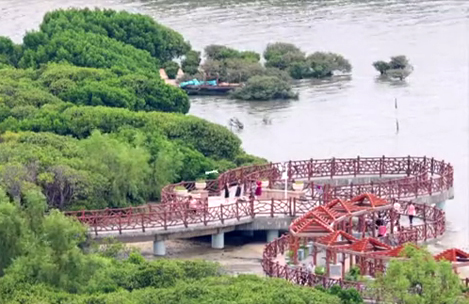Home> Guidelines
Geographical Environment
Location
Zhanjiang city, between 109 degrees 31 minutes - 110 degrees 55 minutes east longitude and 20 degrees 12 minutes - 21 degrees 35 minutes north latitude, is located in the southernmost part of the Chinese mainland and southwest of Guangdong province, covering the northern part of Leizhou Peninsula. Facing Southeast Asia, it is at the juncture of Guangdong province, Guangxi province and Hainan province, with the hinterland of South and Southwest China to the north and the Pacific Ocean to the south.
With a population of 8,042,300, Zhanjiang consists of three county-level cities (Leizhou, Lianjiang and Wuchuan), two counties (Xuwen county and Suixi county) and four districts (Xiashan district, Chikan district, Potou district and Mazhang district). As it possesses one State-approved economic and technological development zone and six province-approved economic development zones, an all-around opening-up pattern has gradually taken shape.
Area
The land area of Zhanjiang totals 12,471 square kilometers, most of which consists of peninsulas and islands.
Surrounded by platform and volcanic islands, the urban district is coastal flatland. Its mid-bay forms a Y-shaped drowned valley – a deep-water channel which has evolved into a deep water harbor, rare in the world. There are also three large rivers, including the Jianjiang River, Nandu River and Jiuzhou River.
Climate
Zhanjiang, which is located in the southern low-latitude region of the Tropic of Cancer, enjoys a tropical and subtropical monsoon climate. Regulated by a marine climate all year, it is neither severely cold in winter nor intensively hot in summer. The average annual temperature ranges between 22.7 C and 23.3 C, with mean annual sunshine duration reaching 1,864-2,160 hours and mean annual precipitation running up to 1,417-1,802mm.
Harbor Resources
Zhanjiang Port, made up of a series of small and medium-sized harbors along the Leizhou Peninsula, is among the 25 principal ports along China's coast and also a leading port on the country's southwestern coast. Zhanjiang boasts a total coastline of 2,043.5 kilometers, taking up approximately 40 percent of the continental coastline of Guangdong province. The planned port shoreline runs up to 168 kilometers, and 67 kilometers of deep-water berth shoreline are available inside the bay. The port is characterized of deep, wide waters and static waves, non-silting all year, with the water depth at the baymouth reaching 26-40m.
In recent years, Zhanjiang Port has seen booming development. New projects include a 300,000-ton onshore oil wharf, a 250,000-ton iron ore terminal, a 150,000-ton coal terminal, a 300,000-ton bulk cargo terminal, a 300,000-ton deep-water channel and a container terminal with a designed annual throughput capacity of 800,000 TEU. The port consists of 125 berths, capable of handling 100 million tons of general cargo annually.
Agricultural Resources
Zhanjiang, located in the tropical and sub-tropical transitional region, enjoys sufficient sunshine and heat. It is known as an important sugarcane area in China, as well as the largest production base for eucalyptus and sisal. In addtion, it has abundant vegetables and varieties of fruit with superior quality, like pineapples, mangos, bananas, red oranges, lychee, longan and watermelons.
Mineral Resources
Zhanjiang is one of the top 10 cities in Guangdong province that enjoy abundant mineral resources. The city is rich in kieselguhr, peat, kaolin, glass-sand, mineral water, ilmenite, zircon, monazite, silverore and graphite. The Beibu Bay coastal shelf is rich in oil and gas resources, with predicted petroleum reserves of 14.5 billion tons and natural gas reserves of 13.2 trillion cubic meters. The region hosts China’s largest offshore gas field, Yacheng 13-1, which has an estimated gas reserve of 100 billion cubic meters.
Aquatic Resources
Facing the sea on three sides, Zhanjiang has a sea area of two square kilometers, a shallow sea beach of 4,890 square kilometers and a total coastline of 2,043.5 kilometers. Its mainland coastline is 1,243.7 kilometers, accounting for 6.4 percent of the country’s total. Zhanjiang’s sea pearl production accounts for two-thirds of the national total, sea salt output makes up half of the provincial total and aquaculture production takes first place in China. The city is also well known as a seafood paradise, and it is China’s largest prawn trading and processing export center.

 Print
Print Mail
Mail 5G construction supports Zhanjiang's high-quality development
5G construction supports Zhanjiang's high-quality development
 Acting mayor inspects project construction in Xuwen, Leizhou
Acting mayor inspects project construction in Xuwen, Leizhou Zhanjiang island an "egret paradise"
Zhanjiang island an "egret paradise"  Dancing egrets add vitality to Xiashan
Dancing egrets add vitality to Xiashan